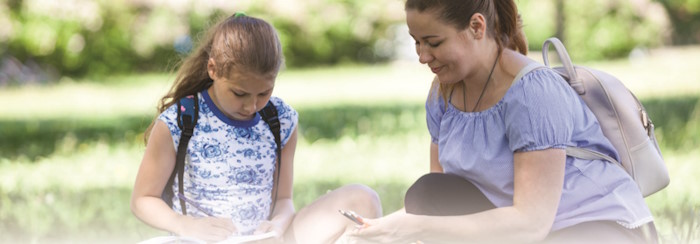Nature Journals for Your Out-Of-The-Box Learners
Kathy Kuhl
Download PDF
Nature journals can provide your family with outdoor fun that helps your distracted kids to thrive. When children keep nature journals, they become more observant. It’s a family activity all ages can enjoy. You can keep nature journals whenever you go, around the world or around the block. Nature journaling is easy, thanks to some great but simple tools.
What are nature journals?
A nature journal is a way for parents and kids to record what they each notice outdoors. In a notebook, we can draw, paint, or write about what we see in nature. It makes us notice details such as the textures of bark, the sounds of a particular birdcall, the colors of an insect or leaf. Nature journaling helps us recall what we have seen.

By attuning us to our environment, nature journaling can help us and our children to settle and experience the outdoors more mindfully. We can pause to enjoy the beauty and pattern in nature, and deepen our curiosity about the world.
How do I teach my kids to use nature journals?
First, get each child a notebook and an easy way to carry whatever they will use to write or draw. Then, go on a walk, or to a park. When you’re ready for a break, pull out snacks, water, and then your journaling gear.
Encourage your kids to record whatever they find interesting in nature—an odd leaf, a bird, a rock. Some children may want to make a sound recording of a bird call. Don’t worry about their spelling. Children who have dyslexia may prefer to dictate a description of what they saw.
If your child is distractible, this time outdoors may help them focus (or hyperfocus), but don’t press them to create a masterpiece of accuracy. The goal is to observe better. It’s a process. If they want to make four observations of thirty seconds each and dash off rough sketches, let them. But look for chances to talk later about what they noticed. Don’t quiz them, but be curious.
Parents should be observing, too. Write what you saw. Jot down the date and location. Don’t hold up your work as an example of how it ought to be done. Just enjoy. Your child’s work may inspire you, but it’s not a contest.
Last spring, my granddaughter noticed a rock. At first, I thought it was just bluestone gravel. But as we saw its curved, concave fractures, we realized it was obsidian. She was curious, so at home we got out a geology guidebook. Then I googled images of rock formations made of obsidian. She loved our instant geology lesson.
Tools for nature journaling
Any small notebook will do. It’s best if it will lie flat. Our family used small Moleskine Cahier Journals (5 x 8 1/4 inches, 13 x 21 cm), which have a sturdy cardstock cover and a pocket in the back. Leuchtturm also uses very good paper, as do others. A friend got decent notebook from a dollar store. My daughter’s family now uses small watercolor pads. If you use paint or markers, be sure to get paper sturdy enough for the colors not to bleed through.
You and your children can use pencils, crayons, colored pencils, watercolor pencils—whatever you like, whatever you have. Put them in a ziplock bag or pencil case. Every child can carry their own implements in a small backpack.
If you’re interested in watercolors, my daughter recommends the medium Pentel Arts Aquash Fine Point Water Brush, which has a built-in water reservoir. It’s easy to use and portable; her children take it to parks and on the trail.
A small magnifier on a lanyard is my favorite tool for your young naturalist. The Private Eye company sells them on different colored lanyards so you can tell whose is whose. The colorful lanyards make the lenses (also called loupes) harder to lose, too.
You may like books by John Muir Laws on nature journaling. The Laws Guide to Nature Drawing and Journaling (Heyday, 2016) is an art instruction book for teaching yourself and your children science and art.
Pick up a nature guidebook or two from the library to thumb through when you get home. Then see which guides you like best and might want to buy.
You might also like folding pocket guides, which are laminated pamphlets that add almost no weight to your backpack. There are sixty-nine in the Pocket Naturalist series, on everything from Florida reptiles to Arctic wildlife.
While I favor keeping kids off phones, you can use the Merlin app to help you identify and learn birdcalls. The iNaturalist app lets you crowdsource identifications of plants and animals. That’s handy, because guidebooks can’t include everything.
Who is John Muir Laws and how can he help our unique kids?
The author of many nature guides, John Muir (“Jack”) Laws credits his lifelong interest in nature and his dyslexic brain with helping him develop skills of persistence, observation, and illustration that led to his career. As a child, Laws spent his free time outdoors, his refuge from school struggles.
During his talk at the 2013 Conference on Dyslexia and Talent, Laws spoke of how nature helped him endure school and develop his keen eye for how different parts of nature interrelate. A short video of the talk, in which he encourages and inspires our struggling learners, is available.
So, get your family outdoors and give nature journaling a try.
WHERE TO FIND
John Muir Laws, “The Dyslexic Naturalist,” presentation at the 2013 Conference on Dyslexia and Talent, hosted by Dyslexia Advantage | https://johnmuirlaws.com/dyslexic-naturalist-video/
The Private Eye Loupe-on-a-Lanyard | theprivateeyestore.com
Available at amazon.com:
- Pentel Arts Aquash Fine Point Water Brush, Medium
- The Laws Guide to Nature Drawing and Journaling; The Laws Guide to Drawing Birds
- Pocket Naturalist Guides, such as Gulf Coast Seashore Life, Rocky Mountain Birds, Wisconsin Wildlife, and many more
 Kathy Kuhl coaches parents who are teaching children with learning challenges. The author of Homeschooling Your Struggling Learner (Learn Differently, 2009), she blogs and advises parents at www.LearnDifferently.com.
Kathy Kuhl coaches parents who are teaching children with learning challenges. The author of Homeschooling Your Struggling Learner (Learn Differently, 2009), she blogs and advises parents at www.LearnDifferently.com.
Other Articles in this Edition
Becoming Comfortable in Your Own Skin
Understanding ADHD from a Strengths-Based Perspective
From Meltdowns to Calm: Helping Children and Teens with Emotional Regulation
ADHD and Family Conflict: How to Reduce Verbal Aggression
Combined ADHD and Autism: How Would You Know?
Does Adult ADHD Increase the Risk of Dementia?
Do Older Drivers with ADHD Outgrow Their Crash Risk?
